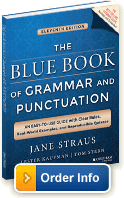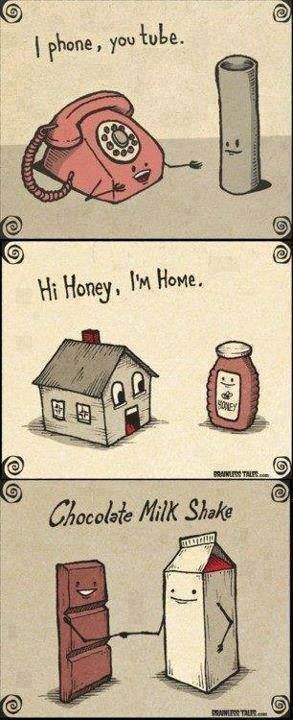|
Welcome to your GrammarBook.com e-newsletter.
|
I found the explanation of when to use whoever or whomever on GrammarBook.com. The information was given in a way that even I could understand and, best of all, remember. I ordered The Blue Book of Grammar and Punctuation and anticipate reading it cover to cover.
—Daryl L.
I have struggled with grammar my whole life. I have a hard time getting all the rules into my head. GrammarBook.com is amazing. The way you explain things is great. Thank you so much.
—Leah
I look forward to receiving each and every one of your e-newsletters. They are always food for thought.
—Sedrick H.
|
|
|
Commonly Confused Words That Bring Bumps to Writing
The English language—its words, its structure, its stylistic
possibilities—is rich, descriptive, and versatile. It can communicate
with precision and convey vivid, persuasive thoughts and ideas.
At times, it can also confuse. Those not familiar with the nuanced or
multiple meanings of many English words and the finer points of grammar can
sometimes trip where they’re looking to stride in their writing. The
good news is removing such stumbling blocks requires only that we identify
those that often appear.
We’ve singled out several speed bumps that remain frequent throughout
current communication, including blogs, websites, magazines, newspapers,
business correspondence, and even novels. Discussing and distinguishing
them allows us to better smooth the road for writing that glides.
Speed Bump:
That
and Which
These pronouns are still often used interchangeably, and some style
arbiters will even say that’s okay today. We say let’s keep
their correct original functions so we can write more concisely.
Compare the following sentences:
I want the train set that is in the store window.
I want the train set which is in the store window.
In spoken language, you’ll probably be understood either way. In
writing, however, the door opens for ambiguity if we don’t correctly
distinguish and punctuate that and which.
That
is a restrictive pronoun that limits or identifies the word or phrase it
modifies. Which is a non-restrictive pronoun that doesn’t
limit or identify.
If we want the specific train set in the window instead of other sets in
the store, we would use that because it defines.
If we’re referring to just one train set without excluding
others—perhaps only one train set is available—we would use which set off with a comma: I want the train set, which is in the store window. The
non-restrictive which also introduces information that enhances
but may not be essential. I want the train set is the main,
unrestricted thought; which is in the store window further
clarifies but is not required for understanding.
Speed Bump:
Lay
and Lie
We’re all familiar with this enigmatic pair dating back to grade
school. Even after decades of reading and writing, some of us can still get
caught on whether to use lay or lie in a sentence.
The best way to distinguish the two is to remember that lay is a transitive verb, i.e., one that requires an object to complete its
meaning: I lay the book on the desk. Its conjugations are lay (present tense), laid (past tense), and laid (past participle).
Lie
is an intransitive verb, which doesn’t require an object for
completion: The sofa lies between the end tables. Its
conjugations are lie (present tense), lay (past tense),
and lain (past participle).
The most common mix-up involves using laid to mean lay: She laid down next to her childhood teddy bear. What we really
mean to express is She lay down next to her childhood teddy bear.
Speed Bump:
Continual
and Continuous
Continual
means over and over again with expected or inherent lapses in time. Continuous means unbroken with no lapses in time.
The
continual
disagreement among the board members last year prevented them from
achieving the quorum they needed.
The family eventually moved to a different location because of the
continuous traffic noise from the nearby interstate highway.
Speed Bump: Envy and Jealousy
Envy
means discontented longing for someone else’s advantages. Jealousy means unpleasant suspicion or an apprehension of rivalry.
Seeing the Joneses driving new cars and wearing designer clothes fueled
the Smiths’
envy.
Seeing Mr. Jones speak to Mrs. Smith every morning outside before work
began to fill Mr. Smith with
jealousy.
As devoted grammarians and observant communicators, we have the focus and
the tools to smooth these bumps in our writing. The result is thoughts and
ideas that both transmit more clearly and perpetuate precision through
proper usage.
Because of the e-newsletter’s large readership, please submit your comments or questions regarding today's (or any past) article through GrammarBook.com’s Grammar Blog
|
|
Free BONUS Quiz for You!
[[firstname]], because you are a subscriber to the newsletter, you get access to one of the Subscribers-Only Quizzes. Click here to take a Who vs. Which vs. That Quiz and get your scores and explanations instantly!
More Good News for Quiz Subscribers
We are pleased to announce that we have added even more quizzes to help you challenge yourself, your students, and your staff. We added quizzes to existing categories and created some new categories such as “Vocabulary,” “Spelling,” “Confusing Verbs,” “Subjunctive Mood,” “Comprise,” and “Sit vs. Set vs. Sat.”
We reviewed and strengthened every quiz on our website to ensure consistency with the rules and guidelines contained in our eleventh edition of The Blue Book of Grammar and Punctuation.
If you think you have found an error in a quiz, please email us at help@grammarbook.com.

“GrammarBook's subscription quizzes opened a new door for me, a way to see exactly who is doing the work and who isn’t, and it is very convenient for the students.”
“So convenient … hundreds of quizzes in one click.”
[[firstname]], Subscribe to receive hundreds of English usage quizzes not found anywhere else!
- Take the quizzes online or download and copy them.
- Get scored instantly.
- Find explanations for every quiz answer.
- Reproduce the quizzes to your heart’s content.
- EASY to use.
- No software to download.
- No setup time.
- A real person to help you if you have any questions!
Instructors and Employers: we make your life easier!
- Assign quizzes to your students or employees.
- Students log in from anywhere.
- Scores are tallied and compiled for you.
- You decide whether to let students see their own scores and quiz explanations.
- Let GrammarBook.com take the hassle out of teaching English!
“Fun to test my skills!”
“The explanations really help … thanks!”
Your choice: Subscribe at the $29.95 or $99.95 level ($30 off - previously $129.95).
“I download the quizzes for my students who don’t have computer access.”
Subscribe today to receive hundreds of English usage quizzes not found anywhere else!
“Makes learning English FUN!”
 |
Don’t need all the quizzes at once?
You can now purchase the same quizzes individually for ONLY 99¢ each. Purchase yours here. |

Get Yours Today!
Get Amazon’s No. 1 Best-seller in Four Categories!
No. 1 in Grammar
No. 1 in Reading
No. 1 in Lesson Planning
No. 1 in Vocabulary |
The Blue Book of Grammar
and Punctuation
by Jane Straus, Lester Kaufman, and Tom Stern
The Authority on English Grammar!
Eleventh Edition Now Available
Have You Ordered Your Copy Yet?
An indispensable tool for busy professionals, teachers, students, homeschool families, editors, writers, and proofreaders.
Available in print AND as an e-Book! Over 2,000 copies are purchased every month!
Order Your Copy Today!
- Hundreds of Grammar, Punctuation, Capitalization, and Usage Rules
- Real-World Examples
- Spelling / Vocabulary / Confusing Words
- Quizzes with Answers
The publisher of The Blue Book, Jossey-Bass, A Wiley brand, is offering a 35 percent discount for those of you who order the book through Wiley.com. Shipping and tax are not included. Simply go to bit.ly/1996hkA and use discount code E9X4A.
*Offer expires December 31, 2017.
|
Wordplay

Learn all about who and whom, affect and effect, subjects and verbs, adjectives and adverbs, commas, semicolons, quotation marks, and much more by just sitting back and enjoying these easy-to-follow lessons. Tell your colleagues (and boss), children, teachers, and friends. Click here to watch. |






